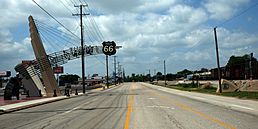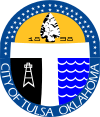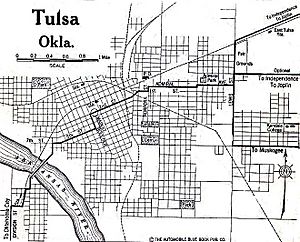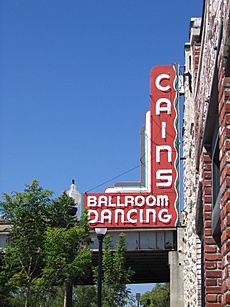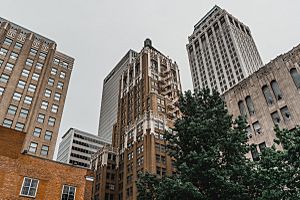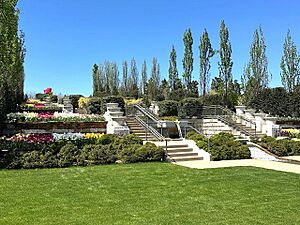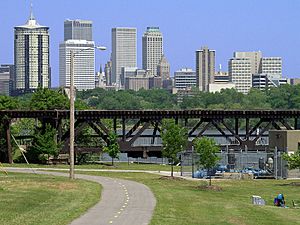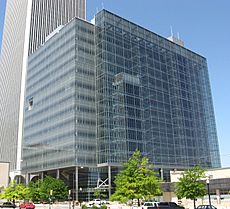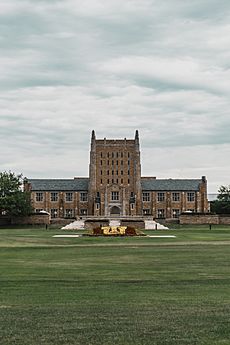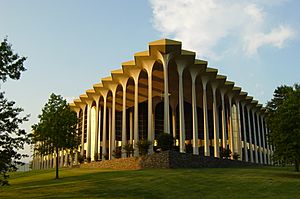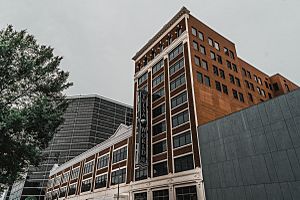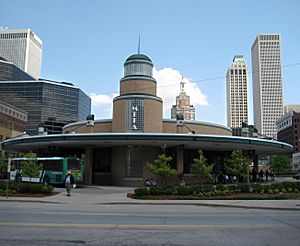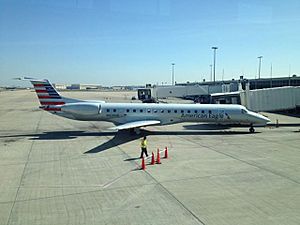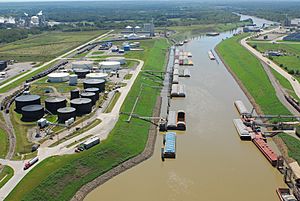Tulsa, Oklahoma facts for kids
Quick facts for kids
Tulsa
Tallasi (Creek)
|
|||
|---|---|---|---|
|
|
|||
|
|||
| Nickname(s):
"Oil Capital of the World", "Tulsey Town", "T-Town", "Green Country", "Buckle of the Bible Belt", "The 918" "The Town"
|
|||
| Motto(s):
"A New Kind of Energy"
|
|||
| Country | United States | ||
| State | Oklahoma | ||
| Counties | Osage, Rogers, Tulsa, Wagoner | ||
| Government | |||
| • Type | Mayor-Council | ||
| Area | |||
| • City | 201.85 sq mi (522.79 km2) | ||
| • Land | 197.76 sq mi (512.21 km2) | ||
| • Water | 4.09 sq mi (10.58 km2) | ||
| Elevation | 722 ft (194 m) | ||
| Population
(2020)
|
|||
| • City | 413,066 | ||
| • Rank | 48th in the United States 2nd in Oklahoma |
||
| • Density | 2,088.67/sq mi (806.44/km2) | ||
| • Urban | 722,810 (US: 60th) | ||
| • Urban density | 2,136.5/sq mi (824.9/km2) | ||
| • Metro | 1,034,123 (US: 54th) | ||
| Demonym(s) | Tulsan | ||
| Time zone | UTC−5 (CST) | ||
| • Summer (DST) | CDT | ||
| ZIP Codes |
ZIP Codes
|
||
| Area code(s) | 539/918 | ||
| FIPS code | 40-75000 | ||
| GNIS feature ID | 1100962 | ||
Tulsa is the second-largest city in Oklahoma, a state in the United States. It is also the 48th most populated city in the entire country. In 2020, about 413,066 people lived there. Tulsa is the main city in the Tulsa metropolitan area, which has over 1 million residents. It is the county seat of Tulsa County. The city's growth has spread into nearby Osage, Rogers, and Wagoner counties.
Native American groups, especially the Lochapoka band of Creek Native Americans, first settled Tulsa between 1828 and 1836. The city officially became a town in 1898. Much of Tulsa is still part of the Muscogee (Creek) Nation's land. Parts of northwest Tulsa are in the Osage Nation, and north Tulsa is in the Cherokee Nation.
For a long time, Tulsa's economy relied heavily on the energy industry. Today, the city has many different types of businesses. Important areas include finance, aviation, telecommunications, and technology. Tulsa was known as the "Oil Capital of the World" for most of the 20th century. It played a big role in the American oil industry.
Tulsa is located by the Arkansas River. It sits in the western foothills of the Ozark Mountains in northeast Oklahoma. This area is often called "Green Country" because of its lush landscape. Tulsa is seen as Oklahoma's center for arts and culture. It has two art museums, professional opera and ballet groups, and many buildings with art deco architecture.
Contents
- Tulsa's Past: A Look Back
- Tulsa's Location and Landscape
- Tulsa's Population and People
- Tulsa's Economy and Jobs
- Arts and Culture in Tulsa
- Food in Tulsa
- Sports in Tulsa
- Parks and Recreation
- Tulsa's Government
- Education in Tulsa
- Media in Tulsa
- Tulsa's Infrastructure
- Famous People from Tulsa
- Sister Cities
- See also
Tulsa's Past: A Look Back
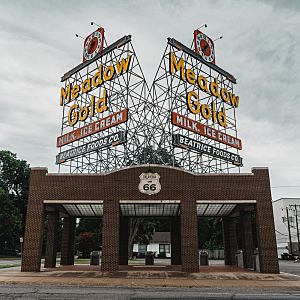
The land where Tulsa is today was once Indian Territory. Many Native American tribes lived here, including the Kiikaapoi (Kickapoo), Wahzhazhe Ma zha (Osage), Muscogee (Creek), and Caddo. The name "Tulsa" comes from a Muscogee settlement called Tvlahasse, meaning "old town." In 1540, Hernando de Soto was the first European to visit this original settlement.
Early Native American Settlements
On March 28, 1836, Opothleyahola and the Muscogee (Creek) Nation started a small village. They called it Lochapoka, which means "place of turtles" in Creek. This settlement was under the Creek Council Oak Tree. Today, this spot is at Cheyenne Avenue and 18th Street. Other "Five Civilized Tribes" also moved to Oklahoma from the Southern United States. Most of modern Tulsa is in the Creek Nation. Some parts are in the Cherokee and Osage Nations.
Even though Oklahoma was not yet a state, the Civil War brought fighting to Indian Territory. Battles happened near Tulsa. After the war, tribes signed treaties with the government. These treaties sometimes meant giving up land. In the years after the Civil War, outlaws like the Wild Bunch and the Dalton Gang visited the area.
Growth and the "Oil Capital" Era
On August 7, 1882, the St. Louis-San Francisco Railroad chose a spot for a train stop. This helped the town grow. On January 18, 1898, Tulsa officially became a city. Edward E. Calkins was elected its first mayor.
Tulsa was a small town when oil was found nearby on June 24, 1901. Much of this oil was on land owned by the Osage Nation. By 1905, the discovery of the huge Glenn Pool Oil Reserve brought many business people to the area. Oil companies like Texaco and Rockefeller's Prairie Oil and Gas Company moved to Tulsa. Tulsa's population grew from 1901 to 1930.
Tulsa was known as the "Oil Capital of the World" for most of the 20th century. The money from oil led to many new buildings in the Art Deco style. Even during the Great Depression, Tulsa's economy did better than most U.S. cities.
The 1921 Tulsa Race Massacre
In the early 1900s, Tulsa had a very successful Black community. It was called "Black Wall Street" in the Greenwood neighborhood. However, on May 31 and June 1, 1921, a terrible event happened. Mobs of White Tulsans attacked the Black community. They destroyed homes and businesses. This event is known as the Tulsa race massacre.
The violence lasted for 16 hours. It only stopped when the National Guard arrived. An official report said 39 people died, but many believe the number was closer to 300. Over 800 people were hurt. About 1,000 Black residents lost their homes. Thirty-five city blocks and 1,256 homes were burned. The damage was estimated at $1.8 million. The city and state have since recognized this tragic event.
Tulsa in the 20th Century
In 1922, Tulsa voters approved money to build the Spavinaw Dam. This was to protect the city's water from oil pollution. The dam was finished in 1924.
In 1925, Tulsa businessman Cyrus Avery helped create U.S. Route 66. He started the U.S. Highway 66 Association in Tulsa. This earned Tulsa the nickname "Birthplace of Route 66."
Bob Wills and his group, The Texas Playboys, made western swing music popular in Tulsa in the 1930s. They performed at Cain's Ballroom, which became a famous music spot. Many famous musicians have played there.
During World War II, Tulsa's economy grew beyond oil. It started making aircraft. A large Douglas Aircraft Company plant opened in 1942. After the war, American Airlines took over a Douglas facility. It moved its entire fleet to Tulsa by 1950. In the 1950s, some oil companies moved their main offices from Tulsa to Houston.
In 1957, Reader's Digest magazine called Tulsa "America's Most Beautiful City." This was because of its airport and decorated public buildings. The city worked on a plan to build more parks, churches, and museums. By the early 1970s, Tulsa had the most manufacturing jobs in Oklahoma.
In 1982, a national economic downturn hit Tulsa hard. Oil prices dropped, and many oil companies left. By 1992, the economy recovered. City leaders then worked to bring in new types of businesses.
Tulsa in the 21st Century
In 2003, voters approved the "Vision 2025" program. This plan aimed to improve Tulsa's buildings and tourism. The main project was the BOK Center. This arena opened in 2008. It hosts hockey, football, concerts, and conventions.
In 2020, the Supreme Court ruled that much of eastern Oklahoma, including Tulsa, is still Native American land. This means that some crimes involving Native Americans are handled by tribal or federal courts.
Tulsa's Location and Landscape
Tulsa is in the northeastern part of Oklahoma. It sits where the Great Plains meet the Ozarks. This area is mostly forested with rolling hills. Tulsa is known as the gateway to "Green Country." This name comes from the region's green plants and many hills and lakes. Northeastern Oklahoma has diverse landscapes. It has seven of Oklahoma's 11 eco-regions. It also has over half of the state's parks.
How Tulsa's Land is Shaped
The city grew on both sides of the Arkansas River. The river's flow is controlled by dams at Keystone Lake and Zink Lake. Tulsa has many hills, like "Shadow Mountain" and "Turkey Mountain." These create varied terrain, especially in the southern parts. The Osage Hills extend into the northwestern part of the city. Holmes Peak, north of the city, is the tallest point in the Tulsa Metro area at 1,360 feet (415 meters). Tulsa covers about 186.8 square miles (483.8 square kilometers). Most of this is land, with some water.
City Views and Buildings
Tulsa's Unique Architecture
Tulsa had a building boom in the early 1900s. This was when art deco architecture became popular. Many of Tulsa's older buildings, especially downtown, show this style. Large art deco buildings include the Mid-Continent Tower, the Boston Avenue Methodist Church, Will Rogers High School, and the Philtower. These buildings attract people interested in architecture.
Tulsa's early wealth also paid for beautiful homes. These homes were built in styles like Craftsmen, Georgian, Tudor, and Greek Revival. You can find many of them in Tulsa's uptown and Midtown areas. Famous architects like Bruce Goff and Frank Lloyd Wright designed buildings in Tulsa. Wright's Westhope home was finished in 1927.
Later in the 20th century, modern architecture came to Tulsa. The BOK Tower is the second tallest building in Oklahoma. Tulsa also has the third and fourth tallest buildings in the state. Oral Roberts University has a unique, futuristic style. The BOK Center, Tulsa's new arena, combines Native American, art deco, and modern styles. It was designed by César Pelli.
Tulsa's Neighborhoods
Downtown Tulsa is about 1.4 square miles (3.6 square kilometers). It is Tulsa's financial and business center. There are plans to improve the area for tourism. Many convention spaces are downtown, like the Tulsa Performing Arts Center and the BOK Center. Important downtown areas include the Blue Dome District and the Brady Arts District. The ONEOK Field baseball stadium opened downtown in 2010.
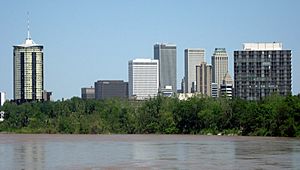
Midtown is Tulsa's historical residential area. It has upscale neighborhoods built in the early 1900s. The University of Tulsa, Swan Lake neighborhood, and Philbrook Museum are here. Shopping areas like Utica Square are also in Midtown. South Tulsa has grown since the 1970s. It has suburban homes and shopping centers. This area includes Woodland Hills Mall and Oral Roberts University. East Tulsa has diverse communities and manufacturing.
Areas west of the Arkansas River are called West Tulsa. They have large parks, nature reserves, and oil refineries. North Tulsa is home to OSU-Tulsa, Gilcrease Museum, Tulsa International Airport, the Tulsa Zoo, and Mohawk Park.
Tulsa's Weather
Tulsa has a mild climate with warm, humid summers and mild winters. The average temperature is about 61.3°F (16.3°C). It gets about 41 inches (104 cm) of rain each year. May is usually the wettest month.
Tulsa often has strong thunderstorms in spring and early summer. These storms can bring large hail, strong winds, and sometimes tornadoes. Tulsa has a good flood control system. This was developed after a severe flood in 1984.
Summer temperatures can reach over 100°F (38°C) about 11 days a year. These hot days often have high humidity. Winters are generally mild. Temperatures can drop below 10°F (-12°C) about three nights a year. The average snowfall is 8.7 inches (22.1 cm). The lowest temperature ever recorded was -16°F (-27°C) in 1930.
2017 Tornado Event
An EF2 tornado hit Tulsa early on August 6, 2017. It caused damage along 41st Street. Two restaurants were badly hit. Several people went to hospitals for treatment.
Tulsa's Population and People
| Historical population | |||
|---|---|---|---|
| Census | Pop. | %± | |
| 1900 | 1,390 | — | |
| 1910 | 18,182 | 1,208.1% | |
| 1920 | 72,075 | 296.4% | |
| 1930 | 141,258 | 96.0% | |
| 1940 | 142,157 | 0.6% | |
| 1950 | 182,740 | 28.5% | |
| 1960 | 261,685 | 43.2% | |
| 1970 | 331,638 | 26.7% | |
| 1980 | 360,919 | 8.8% | |
| 1990 | 367,302 | 1.8% | |
| 2000 | 393,049 | 7.0% | |
| 2010 | 391,906 | −0.3% | |
| 2020 | 413,066 | 5.4% | |
| 2024 (est.) | 415,154 | 5.9% | |
| U.S. Decennial Census | |||
In 2020, Tulsa's population was 413,066. The city is home to people from many different backgrounds. About 48.48% of the population was White (not Hispanic). About 14.65% was Black or African American. Native Americans made up about 4.59%. Asian people were 3.43%. People of two or more races were 9.13%. Hispanic or Latino people made up 19.14% of the population.
In 2010, there were 163,975 households in Tulsa. About 27% of households had children under 18. The average household size was 2.34 people. The median age in the city was 34 years. In 2011, the average household income was $40,268. About 19.4% of the population lived below the poverty line. Most adults in Tulsa have a high school diploma. About 29.8% have a bachelor's degree or higher.
Tulsa's Metro Area
The Tulsa Metropolitan Area is the region around Tulsa. It has strong social and economic ties to the city. This area is also known as "Green Country." The U.S. Census Bureau calls it the Tulsa Metropolitan Statistical Area (MSA). It includes seven counties. In 2020, the Tulsa MSA had 1,015,331 residents.
Religious Life in Tulsa
Tulsa has many religious followers, mostly Christians. It is part of the "Bible Belt" region. Many Protestant and evangelical Christian churches are here. Tulsa is sometimes called the "buckle of the Bible Belt." This is because it has Oral Roberts University and other religious schools.
Tulsa also has many other Christian churches. Some have beautiful architecture, like the Boston Avenue Methodist Church. The city has the largest Jewish community in Oklahoma. The Sherwin Miller Museum of Jewish Art has a large collection of Jewish items. Tulsa is also home to the All Souls Unitarian Church, one of the largest Unitarian Universalist churches in the U.S.
Tulsa's Economy and Jobs
Oil Industry's History and Growth
The United States Oil and Gas Association started in Tulsa in 1917. Many big oil companies have had their main offices here. While some companies moved away, new drilling methods have helped Tulsa's energy sector grow again.
Today, Tulsa is home to many international oil and gas companies. These include Williams Companies, ONE Gas, and ONEOK.
New Industries and Growth
Tulsa has worked to grow its economy beyond oil. It is now a regional center with many new businesses. Tulsa manufacturers make about 60% of Oklahoma's exports. In 2001, the city's total economic output was over $29 billion.
Most jobs in Tulsa come from small and medium-sized businesses. Over 80% of the city's companies are small businesses.
From 2001 to 2003, Tulsa lost many jobs. To help, the "Vision 2025" plan was created. This plan aimed to bring economic growth and new jobs. It included projects for city improvements and tourism. By 2007, job numbers were higher than before the downturn. Tulsa's economy has been growing.
Besides oil, Tulsa's economy now includes aerospace, finance, technology, and manufacturing. Many financial companies are based in Tulsa, like the BOK Financial Corporation. Other companies headquartered here include the convenience store chain QuikTrip and restaurant chains like Camille's Sidewalk Cafe and Mazzio's.
Tulsa also has a growing media industry. This includes publishers like PennWell and local news outlets. Construction and engineering companies like Manhattan Construction Company are also based here.
The aerospace industry in Tulsa is large and growing. An American Airlines maintenance base at Tulsa International Airport is the city's largest employer. It is the biggest maintenance facility in the world. In 2020, American Airlines announced a $550 million investment in this base. The Tulsa Port of Catoosa and the airport have many industrial parks. Tulsa is also home to a division of Lufthansa and Spartan College of Aeronautics and Technology.
Tulsa is part of a region known for drone technology. The city's central location makes it a hub for logistics businesses. Amazon recently announced plans for a large fulfillment center near the airport. This facility will create about 1,500 jobs.
Arts and Culture in Tulsa
Tulsa's culture is a mix of influences. These come from the nearby Southwest, Midwest, and Southern regions. Native American history also plays a big part. This can be seen in the city's museums, arts groups, and festivals.
Museums and Art
Tulsa has several museums. The Philbrook Museum of Art is in a former oil pioneer's home. It is considered one of the top art museums in the U.S. It has a historic home, gardens, and a large art collection. The collection includes works by Pablo Picasso and Georgia O'Keeffe.
The Gilcrease Museum is in the Osage Hills. It has the world's largest collection of art and items from the American West. This includes works by Frederic Remington.
The Tulsa Botanic Garden is a large public garden. It has art, water features, and aims to protect the local environment. The Oklahoma Aquarium is the state's only standalone aquarium. It has over 200 exhibits, including a shark tank.
Tulsa also has many art galleries and smaller museums. Living Arts of Tulsa helps support the city's art scene.
Historical Archives
The Woody Guthrie Center opened in 2013. It is in the Tulsa Arts District. It has interactive museum displays and the Woody Guthrie Archives. These archives contain many of Guthrie's personal items. The archives of Bob Dylan will also be displayed in Tulsa.
The Church Studio is a recording studio and tourist spot. It has an archive of over 5,000 items. Musician Leon Russell turned the old church into a recording studio in 1972.
The Sherwin Miller Museum of Jewish Art has the largest collection of Jewish items in the South-Central and Southwestern U.S. The Greenwood Cultural Center preserves the history of Tulsa's African American heritage. It has items and photos from the "Black Wall Street" before the 1921 Tulsa Race Massacre.
Public Art in Tulsa
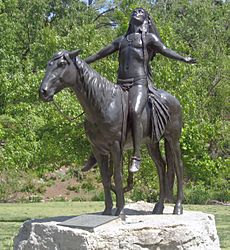
Since 1969, Tulsa has used one percent of its city budget for public art. Sculptures are placed along the Arkansas River trail system. Others are in parks, like Cyrus Dallin's Appeal to the Great Spirit in Woodward Park. A large statue of praying hands stands at Oral Roberts University. It is 60 feet (18 meters) high. The Golden Driller is a 76-foot (23-meter) statue. It stands at the Tulsa County Fairgrounds. It shows the city's oil history.
Tulsa has many exhibits about U.S. Route 66. The Cyrus Avery Centennial Plaza has a large sculpture called "East Meets West." It shows the Avery family meeting a horse-drawn carriage. Tulsa also has "Route 66 Rising," a large sculpture on the road's eastern approach. There are 29 historical markers along the highway through Tulsa.
In 2021, "The Majestic" mural was completed downtown. It is the largest augmented reality mural in the world. It becomes animated when viewed through a smartphone.
Tulsa's City Flag
Tulsa's flag is considered one of the most attractive city flags in the U.S. In 2023, it received an A+ rating from the North American Vexillological Association.
The Tulsa City Council adopted the new flag in 2018. The design includes a dreamcatcher. This represents the Tulsa settlement under the Council Oak Tree. The color red represents those who died in the Tulsa race massacre. Blue stands for the Arkansas River. Gold represents the discovery of oil.
Performing Arts and Music
Tulsa has many dance, theater, and music groups. These include the Tulsa Ballet, Tulsa Opera, and Tulsa Symphony Orchestra. Theatre Tulsa is the oldest continuously running community theatre west of the Mississippi River. The Tulsa Spotlight Theater shows the longest-running play in America, The Drunkard, every Saturday.
Tulsa's music scene is famous for the "Tulsa Sound." This sound mixes rockabilly, country, rock 'n' roll, and blues. Artists like J.J. Cale and Leon Russell helped create it. Cain's Ballroom is a well-known music venue. It is considered the birthplace of Western Swing. The Brady Theater is another important venue in the downtown Brady Arts District.
Large performing arts places include the Tulsa Performing Arts Center and the BOK Center.
Outdoor Fun
The Tulsa Zoo covers 84 acres (34 hectares). It has over 2,600 animals from 400 species. The zoo is in Mohawk Park, one of the largest municipal parks in the U.S.
The Tulsa State Fair happens in late September and early October. It attracts over one million people. Other festivals include the Intertribal Indian Club Powwow of Champions and Scotfest. Mayfest is an annual arts and crafts festival downtown. Tulsa also has a water park called Paradise Beach Waterpark.
Music Scene
Western Swing music became popular at Tulsa's Cain's Ballroom. The Tulsa Sound is a mix of country, blues, and rock 'n' roll. It was developed by local musicians like J. J. Cale and Leon Russell. Many musicians started their careers in Tulsa, including Garth Brooks and Hanson. The heart of the Tulsa Sound is at The Church Studio.
Public Libraries
The Tulsa City-County Library is the largest library system in the area. It has over 1.7 million books in 25 locations. The library offers free computer classes and children's storytimes. The McFarlin Library at the University of Tulsa has over three million items. It is known for its Native American works and original works by James Joyce.
Food in Tulsa
Tulsa has many restaurants and food trucks. Several types of food are very popular because of the city's history.
Barbecue (BBQ)
Tulsa is known for its barbecue. Its BBQ style is a mix of Southern and Western traditions. The area has plenty of wood for smoking, like pecan and hickory. Tulsa's BBQ also shows influences from different cultures.
Some Tulsa BBQ places have grown beyond the state. These include Leon's Smoke Shack and Rib Crib. Oklahoma Joe's started in Tulsa. Oklahoma barbecue often features hickory-smoked bologna and fried okra.
Lebanese Steakhouses
Lebanese steakhouses were once common in the region. Now, most are in the Tulsa area. These restaurants were started by Syrian and Lebanese families. They came to Oklahoma before it became a state. These places often serve Mediterranean dishes like tabbouleh and hummus.
Chili and Hot Dogs
People in Oklahoma have eaten chili for a long time. This is due to the influence of Mexican-American culture. Ike's Chili Parlor opened in Tulsa in 1910.
Greek immigrants brought the tradition of Coney Island-style hot dogs to Tulsa. These hot dogs have chili on a bun. Today, Greek-American families run Coney restaurants around the city. Coney I-Lander opened in 1926. Many of these restaurants also sell Greek food.
Southern "Homestyle" Food
Tulsa's traditional food shows Southern influences. Many of Oklahoma's early settlers came from the South and Texas. Foods like chicken-fried steak are popular. It is the signature dish at many Tulsa restaurants.
Wild Onion Dinners
The wild onion dinner is a special meal from the Southeastern tribes in Eastern Oklahoma. These meals often include wild onion, pork, frybread, and corn bread. The Tulsa Indian Women's Club has held these dinners since at least 1932.
Sweets and Bakeries
Tulsa hosts the Oklahoma Sugar Arts Show. This is a top sugar craft competition. Tulsa is also home to Pancho Anaya Mexican bakery, known as one of America's best. Daylight Donuts and Bama Pie Company are also based in Tulsa.
Breweries
Tulsa's craft beer scene has grown. Marshall Brewing Company opened in 2008. This was Tulsa's first microbrewery after World War II.
Sports in Tulsa
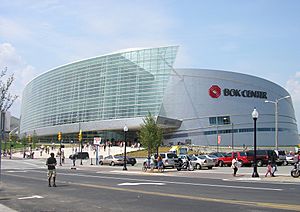
Tulsa has many professional and college sports teams. The city has two NCAA Division I colleges. It also has minor league teams in baseball, football, hockey, and soccer.
Professional Sports Teams
| Club | Sport | League | Venue |
|---|---|---|---|
| FC Tulsa | Men's Soccer | USL Championship | ONEOK Field |
| Tulsa Oilers | Ice hockey | ECHL | BOK Center |
| Tulsa Oilers | Indoor football | IFL | BOK Center |
| Tulsa Drillers | Baseball | Texas League | ONEOK Field |
| Tulsa Athletic | Men's soccer | National Premier Soccer League | Hicks Park |
| Tulsa Rugby Football Club | Rugby Union | Division III Rugby | 37th Riverside Field |
The Tulsa Drillers are Tulsa's Class AA baseball team. Famous players like Sammy Sosa played for the Drillers. In 2008, Tulsa funded a new ballpark for the Drillers. ONEOK Field opened in 2010.
The BOK Center is a large arena with 19,199 seats. It opened in 2008. It was once home to the Tulsa Shock (WNBA) and Tulsa Talons (arena football). As of 2022, the Tulsa Oilers ice hockey team is the main tenant.
College Sports
| School | Nickname | Colors | Association | Conference |
|---|---|---|---|---|
| University of Tulsa | Golden Hurricane | Old Gold, Royal Blue and Crimson | NCAA Division I | American |
| Oral Roberts University | Golden Eagles | Vegas Gold and Navy Blue | NCAA Division I | Summit |
Two Tulsa universities compete in NCAA Division I sports. These are the University of Tulsa Golden Hurricane and the Oral Roberts University Golden Eagles. The University of Tulsa's men's basketball team has reached the Sweet Sixteen three times. They won the NIT championship twice. The Tulsa football team has played in 16 bowl games.
Oral Roberts University's men's basketball team reached the Elite Eight in 1974 and the Sweet Sixteen in 2021.
The University of Tulsa has a top tennis facility. It hosted the NCAA tennis championships in 2004 and 2008.
Golf Courses
Tulsa is home to the Southern Hills Country Club. This course has hosted seven major golf championships. It has held three U.S. Opens and four PGA Championships.
Tulsa also has two golf courses designed by A.W. Tillinghast. These are the Oaks Country Club and Tulsa Country Club.
Running and Biking
Tulsa has many trails for running and cycling. Events like the Tulsa Tough cycling race and the Route 66 Marathon are held here. The Tulsa Run has over 8,000 participants each year.
Saint Francis Tulsa Tough Ride and Race is a three-day cycling festival. It includes both fun rides and professional races. It is held every June.
Motorsports
Tulsa hosts the Chili Bowl indoor race every year. This race takes place at the Tulsa Expo Center.
Parks and Recreation
As of 2016, Tulsa manages 134 parks. These cover over 8,278 acres (3,350 hectares). Woodward Park is a 45-acre (18-hectare) botanical garden. It has the Tulsa Municipal Rose Garden with over 6,000 rose plants.
Some parks are run by Tulsa County Parks. These include LaFortune Park and Chandler Park.
The Tulsa River Parks Authority manages parks along the Arkansas River. These parks have new trails and playgrounds. The Turkey Mountain Urban Wilderness Area has over 45 miles (72 kilometers) of dirt trails. These are for hiking, running, biking, and horseback riding.
Gathering Place is a 66-acre (27-hectare) park. It has a playground, boathouse, splash area, sports courts, and trails.
Bicycling in Tulsa
Tulsa has many cycling trails. It has also added protected bike lanes downtown. The city's "GoPlan" aims to expand this bike infrastructure.
Tulsa's Government
Tulsa has a mayor-council government. This system started in 1989. The mayor has more power in this system. Mayors serve a four-year term. The current mayor of Tulsa is Monroe Nichols. He took office on December 2, 2024.
A city councilor is elected from each of the city's nine districts. Councilors serve two-year terms. The city council makes laws and approves the city budget. The city auditor is elected separately. This ensures the auditor can be objective. The auditor serves a two-year term.
Tulsa is the seat of government for Tulsa County. Most of the city is in Oklahoma's 1st congressional district. The Tulsa Police Department enforces laws in Tulsa. It has 781 officers.
Education in Tulsa
K–12 Schools
Tulsa Public Schools is the second-largest school district in Oklahoma. It has nine high schools and over 41,000 students. In 2006, over 90,000 students attended public schools in Tulsa County.
Parts of Tulsa are in other school districts. These include Berryhill, Bixby, Broken Arrow, Jenks, Owasso, and Union.
Tulsa also has many private schools. Most of these schools have religious ties. The Catholic Diocese of Tulsa supports schools like Bishop Kelley High School. Holland Hall School is independent but connected to the Episcopal Church.
History of K-12 Education
The Presbyterian Church started the Presbyterian Mission Day School in 1884. This was Tulsa's first school. In 1899, Tulsa took over the school, making it the first public school.
Tulsa built its first two public schools in 1905. More schools were built starting in 1906. In 1907, the Tulsa Board of Education took control of the public schools.
Tulsa High School opened in 1906. It was replaced by Central High School in 1917. The old building is now used by the Public Service Company of Oklahoma.
Colleges and Universities
The first college in Tulsa was Kendall College. It moved to Tulsa in 1907. In 1920, it became the University of Tulsa (TU).
Tulsa has 15 colleges and universities. These include two private universities: the University of Tulsa and Oral Roberts University.
The University of Tulsa has about 3,832 students. It offers doctoral and master's programs. It is also home to the University of Tulsa College of Law. TU manages the Gilcrease Museum.
Oral Roberts University is a Christian university. It has about 5,109 students.
Both of Oklahoma's main research universities have campuses in Tulsa:
- Oklahoma State University has three campuses in Tulsa. These include the Oklahoma State University - Center for Health Sciences and Oklahoma State University - Tulsa.
- The University of Oklahoma has the OU-Tulsa Schusterman Center. It offers bachelor's, master's, and doctoral degrees. It also has the OU School of Community Medicine.
Rogers State University in Claremore is a public four-year university for the Tulsa area. Tulsa Community College (TCC) is the largest community college in Oklahoma. It has four campuses. Tulsa also has a branch of Langston University, the only historically Black college in the state.
The Spartan School of Aeronautics trains students for flight programs. Tulsa Technology Center is the oldest and largest vocational technology school in Oklahoma.
Media in Tulsa
Print News
Tulsa's main newspaper is the daily Tulsa World. It is the second most widely read newspaper in Oklahoma.
The Tulsa Voice is a weekly newspaper about entertainment and culture. The Tulsa Business Journal covers economic news. Other publications include the Oklahoma Indian Times and the Tulsa Beacon. The first Black-owned newspaper was the Tulsa Star. It was replaced by the Oklahoma Eagle.
TV and Radio
Tulsa has many television and radio stations. All major U.S. TV networks have local stations in Tulsa. These include NBC (KJRH-TV), CBS (KOTV-DT), and ABC (KTUL). There are also religious TV stations.
Cable television service is provided by Cox Communications.
Tulsa's Infrastructure
Getting Around Tulsa
Transportation in Tulsa uses the Tulsa Transit bus network and two main airports. The Tulsa Port of Catoosa helps move goods through international trade.
Highways
Tulsa has a large highway system. It connects to cities like Joplin, Missouri, and Oklahoma City. Many people use highways to get to work. Major highways include I-44, I-244, US-412, and US-75. The Inner Dispersal Loop connects downtown to most highways.
In 2023, the Interstate 42 designation was approved for parts of US-412, including a segment of I-244 in Tulsa.
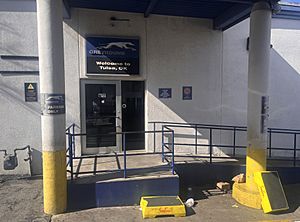
Buses
Tulsa Transit operates 97 buses on 19 routes. These routes cover Tulsa and nearby suburbs. Tulsa Transit has two main stations. Most routes go through one or both stations. Buses stop at colleges, medical centers, and shopping areas. Tulsa launched its first bus rapid transit line, Aero on Peoria Avenue, in November 2019.
Intercity bus service is provided by Greyhound Lines and Jefferson Lines.
Airports
Tulsa International Airport serves over three million travelers each year. It has service from twelve commercial airlines. In 2007, the airport finished a big expansion project. Richard L. Jones Jr. Airport is a general aviation airport. It is the busiest airport in Oklahoma for small planes.
Railways
Freight railways cross Tulsa in all directions. BNSF operates the Cherokee Rail Yard in Tulsa. Other major freight transporters include Union Pacific Railroad and CPKC.
Tulsa does not have mass transit rail lines. There are no passenger trains directly serving Tulsa today. However, a proposed Amtrak route from Oklahoma City to Tulsa is being considered for federal funding.
Tulsa has two old steam locomotives on display. One is at the Tulsa State Fairgrounds. The other is at the Route 66 Historical Village.
Port of Catoosa
The Tulsa Port of Catoosa is a large inland port. It connects Tulsa to the Mississippi River through the Verdigris River and the Arkansas River. It is one of the biggest riverports in the U.S.
Medical Facilities
The Saint Francis Health System owns several hospitals. Its main location is Saint Francis Hospital. This hospital has 700 doctors and 918 beds. It is the second-largest healthcare employer in Oklahoma. St. John Medical Center is another large hospital in Midtown.
Famous People from Tulsa
Sister Cities
Tulsa has nine international sister cities. This is part of the Tulsa Global Alliance. It helps build understanding between cultures.
- Amiens, France
- Beihai, China
- Celle, Germany
- Kaohsiung, Taiwan
- Mwanza, Tanzania
- San Luis Potosí, Mexico
- Tiberias, Israel
- Utsunomiya, Japan
- Zelenograd, Russia
See also
 In Spanish: Tulsa para niños
In Spanish: Tulsa para niños
- Tulsa (book)
- Tulsa (movie)
- List of oil refineries
- USS Tulsa, 3 ships





